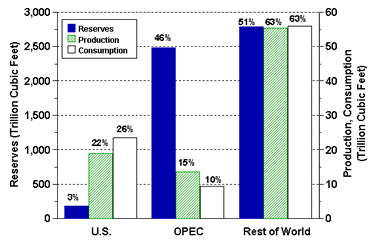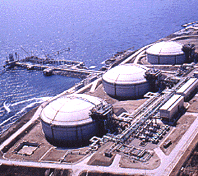Michael Fumento
Factual · Powerful · Original · Iconoclastic
Fuelish Attack on Natural Gas
June 08, 2004 · Michael Fumento · Scripps Howard News Service · EnvironmentNatural gas is the cleanest fossil fuel, one reason it provides almost a fourth of U.S. energy and heats over half our homes. But already North America can’t meet the continent’s gas needs. With America’s growing energy requirements, the amount we’ll need to import is expected to double within 20 years. If some people have their way, though, that supply – and we – will be choked off.
 Another nice thing about natural gas: OPEC produces very little.
Another nice thing about natural gas: OPEC produces very little.
For shipping, natural gas is liquefied through super-chilling. This reduces the volume by 600 times. LNG also doesn’t burn. At the receiving terminal, it’s warmed back into a gas and piped where needed. Currently, the United States has only four receiving terminals, none west of Louisiana. We need more and it’s obvious where. California’s population is huge and surging, as are its energy needs. It also has the nation’s strictest environmental laws, thereby favoring natural gas. But although various companies have proposed terminal locations, over two-dozen environmental groups are fighting them all.
Why? Environmental activists hate all affordable forms of energy, no matter how clean, because it’s the lifeblood of industry. To them, Saddam Hussein may be bad but industry is absolutely evil. Although not building a terminal "would be a recipe for unacceptable economic hardship for those who can least afford it," according to two true top-ranking California environmentalists in a recent op-ed, the activists in green paint couldn’t care less.
There are also the NIMBY groups, who recognize California’s need for a terminal but Not in My Back Yard. They don’t want any new industry near them that is heavier than, say, flower arrangement.
But such ideas can’t be sold to the broader public, so other reasons are concocted. Since fear sells, naturally, activists point out that natural gas can explode.
 There has never been an explosion at an LNG receiving terminal.
There has never been an explosion at an LNG receiving terminal.
In reality, LNG has a terrific safety record. There has never been a shipboard explosion, and while there are 113 active LNG facilities in the United States, only one has had an accident with outside fatalities. That was in 1944, caused by a holding tank that was improperly made because of a wartime shortage of materials. Further, safety technology continually improves. Algeria had a fatal LNG explosion last year attributed to a steam boiler, but boilers are only used at the shipping end. Over 40 LNG receiving terminals operate worldwide; none has had a significant accident.
True, some proposals do have pitfalls.
For example, Japan’s Mitsubishi wants a terminal in Long Beach Harbor. That’s a bad place for something to go boom because it’s also the location of the nation’s busiest port. Since Mitsubishi also has a nasty history of price fixing regarding such things as plastic wrap, fax paper and graphite electrodes, it’s natural that Californians would be worried about giving it the state’s first LNG terminal.
ChevronTexaco of San Ramon, Calif., proposes a terminal near the Marine Corps’ Camp Pendleton, but it’s still near a population center (the base), near a nuclear power plant, and it could disrupt the flow of goods and services along one of the state’s major transportation corridors (Interstate 5).
Sempra Energy of San Diego wants a terminal in Baja Mexico. That’s certainly out of California’s back yard. But placing it in Mexico runs the risk the government could nationalize it. It could then divert some or all of the gas or simply charge whatever it feels. Californians are also distrustful of Sempra because of its role in the 2000 energy crisis.
On the other hand, Australia’s BHP Billiton plans to build a floating terminal 14 miles offshore so that there would be no impact on land, no interference with shipping – and the largest possible explosion wouldn’t singe a single hair on the mainland. As one of the largest proposed terminals, it would supply a tenth of California’s gas needs by 2008.
Yet since environmentalists are dead-set against any terminal, they’re fighting even this one. And, yes, NIMBYs oppose it, although by definition it’s in no one’s back yard.
At some point, still another California terminal will be required. But if Ahnuld’s state terminates even this one, surely the others have no chance. Then when the energy shortage hits, the consumers’ fuel of choice may be burning activists at the stake.
